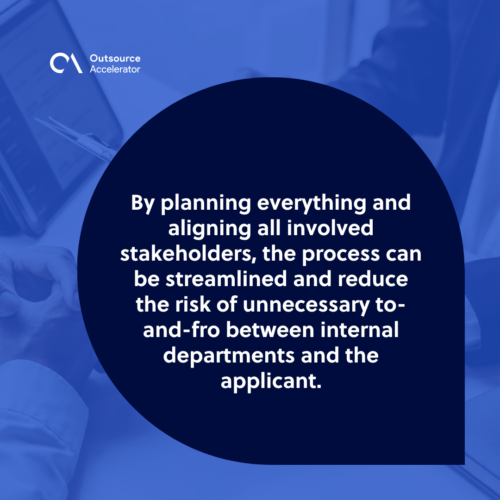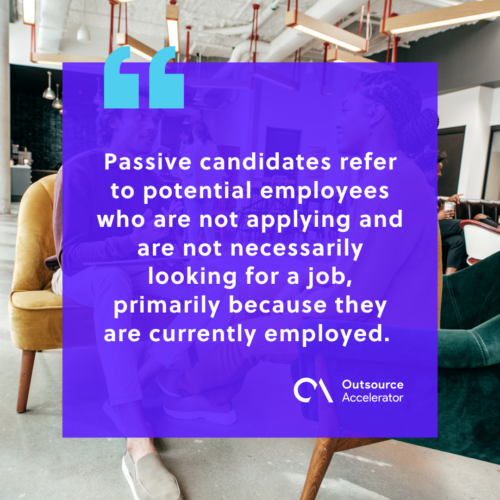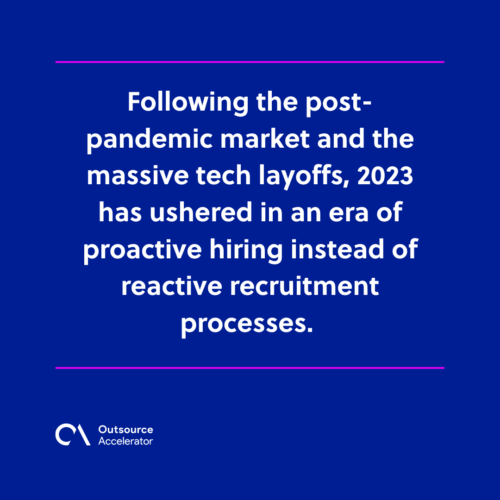7 modern recruitment challenges and how to solve them

Changes in technology and business practices have altered how companies find, recruit, and hire talents. There are more channels to navigate, but the main objective remains – to find and get the best talents for a particular position.
Recruitment is equally challenging for both recruiters and applicants, with 73% of job seekers finding it the most stressful part of their career.
From keeping up with new tech trends to bridging existing recruiter-talent gaps, here are seven persisting recruitment challenges and what you can do to solve them.
What does a standard recruitment process look like?
Gone are the days when employers would have to advertise job openings on physical boards and traditional media.
Job announcements and even recruitment processes can now be conducted in fully remote settings. Regardless of the platform, the standard recruitment process can be divided into five stages:
Planning
In this stage, the recruitment team receives a workforce request in an organization. A hiring strategy is devised, identifying the following needs:
- Job title
- Character profile for the target candidate
- Salary package and benefits
- Channels where the opening will be listed
- Recruitment and hiring timeline
- Documents, forms, and training materials
A report from the Society of Human Resource Management (SHRM) revealed that the average time to fill a position is at 42 days.
By planning everything and aligning all involved stakeholders, the process can be streamlined and reduce the risk of unnecessary to-and-fro between internal departments and the applicant.

Attracting talents
Once the platforms where the job opening will be posted are determined, it’s time to start attracting talents. Traditional media include physical job boards, local newspapers, or even TV and radio.
With today’s technology, however, companies can post their openings on online job marketplaces or even on social media pages such as Facebook or LinkedIn.
Software firm CareerArc reported that about nine out of every ten applicants (86%) rely on social media for job hunting.
Screening and selection
Once the applications start pouring in, the recruitment team has to sort candidates to identify who gets to be interviewed and potentially hired.
The screening process involves evaluating each applicant’s educational background, relevant work experience, and current location.
After interviewing the shortlisted candidates, the hiring team will conduct background checks. This is often centered around credit history or potential criminal records, especially in regulated industries where a character’s background can interfere with their job once hired.
Professional firms like Logix BPO specialize in rooting out the best candidates to ensure that you receive the talent that fits your culture and requirements.
Job offer and onboarding
After passing the interview and the required checks, it’s time to make the decision. Successful candidates are often called into a meeting to discuss their job offers and the company’s expectations should they continue.
Once done, candidates are given the tools they need to start with the company. This is usually accompanied by a preparatory course or an onboarding process to ease them into the organization.
Evaluation
Aside from keeping an eye on the performance of the newly-hired employee, the very recruitment process also requires an evaluation.
Consider the timing and the character of the chosen candidate and see how these outputs fared against the targets set during the planning stage.
7 recruitment challenges and how to overcome them
The changing recruitment landscape, paired with an increasingly competitive job market, has given rise to a new set of challenges on top of existing ones.
Below are some of the most common recruitment roadblocks and what you can do to address them:
1. Apparent talent shortage
The National Federation of Independent Business (NFIB) reported that 87% of HR professionals “reported few or no qualified applicants” for open positions.
This is a persisting problem in the recruitment space when the recruiters can’t seem to find the perfect candidate from their pool of applicants.
Companies have no choice but to settle for lesser candidates or leave the position unfulfilled.
Solution: Cast wider nets and examine employer branding
Instead of simply accepting that there is a talent shortage, consider the possibility that you’re looking at the wrong spaces.
Look into other job platforms, or incentivize employee referrals so you can expect team members to spread the news about job openings at your company.
On referrals, it might also warrant an introspective approach. Employer branding refers to how you project your company’s image and how others see them, which 72% of recruitment leaders recognize as a factor in securing talents.
Apart from in-house recruitment, you can also look for offshore service providers such as Clark Staff to help you access better talents in other destinations.
2. Getting the right candidate
Once job openings are out, recruiters are often met with a lot of applications and inquiries from interested parties.
Common issues about finding the right candidate include having limited options from the pooled talents or being overwhelmed with the sheer number of applications.
Solution: Specify your hiring requirements
One practice that could streamline your hiring pipeline and attract more promising candidates is to be more specific about the position you’re offering and the requirements that it entails.
The more details you offer, the more potential employees will be able to assess themselves and save time.
3. Closing passive candidates
Passive candidates refer to potential employees who are not applying and are not necessarily looking for a job, primarily because they are currently employed.
While not actively in the open job market, they are often targeted by recruiters because of their skills, experience, and qualifications.
The need to close passive candidates become more frequent as you hunt candidates for higher positions. In some cases, executive search software platforms are enough to connect companies with passive candidates that meet their criteria.
Solution: Adopting a range of passive recruitment strategies
For new recruiters, it helps to know that there are existing passive recruitment strategies, often reserved for characters in managerial and executive roles.
LinkedIn reports that about 49% of passive talents are interested in hearing about new opportunities.
One preferred approach to attracting passive candidates is through social media. Posts and blog articles are effective tools for communicating your message to the market.
Another strategy by industry leaders is by hosting special events focused on learning and development and then gather the leading talents in the field.

4. Bridging skill gaps
This problem is more common for entry-level positions when there’s a need to fill in a position usually reserved for fresh graduates and younger talent pools.
In fact, a 2022 study from ECI Partners showed that the lack of technical skills and knowledge had become the biggest obstacle in hiring.
Solution: Upskilling, flexibility, and inclusivity
While it sounds like an indictment of the education system, recruiters still have the ability to address the issue. One positive approach is to encourage upskilling.
5. Robust vs. Flexible work schedules
One of the biggest impacts of the pandemic is emphasizing the viability of remote work. As such, a staggering 98% of surveyed workers would like to experience at least partial remote work arrangements.
Some companies have permanently included remote and hybrid work arrangements.
Solution: Remote-ready workplace or offer good counterarguments
If you’re looking to accommodate remote or hybrid workers, let them know that the workplace is ready for them. Communications, tech, and workflow are the most important aspects that prospective employees should know beforehand.
Conversely, since not all companies can make such offers, recruiters can still make a case for office work. After all, the desire to work remotely is largely driven by the need to achieve a work-life balance, and the right applicant for your team might consider it.
6. Improving time-to-hire and time-to-fill metrics
Time-to-hire (TTH) refers to the period between the first entertained applicant and the contract signing. Time-to-fill (TTF), on the other hand, is a slightly longer period that extends from the decision to make the job opening and signing the contract.
Either way, these are common metrics used to gauge a recruiter’s performance.
A Robert Half survey on 1,000 American workers revealed that about 57% of applicants lose interest in a position when the hiring process takes too long.
Solution: Examine existing metrics and align expectations
Both TTF and TTH metrics are based on a wide range of factors, some of which are within your control while others aren’t. Example of the latter includes market conditions and the industry.
To improve these metrics, set up a structured hiring process supported by data. By understanding things such as your existing timeframes, you can align all expectations and start identifying opportunities for improvement.
7. Overcoming recruitment biases
While diversity and inclusion are making strides, there are institutionalized practices in human resources that inadvertently hinder further progress. Some of these biases are ingrained and practitioners do them without realizing their impact down the line.
For example, confirmation bias happens when data or responses from the applicant confirm the recruiter’s existing beliefs or preconceptions. Affect heuristics refer to emotions overriding objective decision-making, like a mental shortcut toward recruitment.
Solution: Data-driven recruitment practices
Biases are overcome when cold, hard facts are presented and followed. Like most recruitment problems, a robust hiring procedure that is backed by data gives you a solid guide.
The challenge, however, is in making the conscious decision to follow the data and not other factors like instincts, urges, and emotions.
Similarly, recruiters can try the following practices:
- Use inclusive languages or words that do not imply prejudice against people of a particular gender, race, or religion.
- Adopt a structured interviewing process, such as a set of questions prepared beforehand.
- Enlist the help of an interview panel or a collaborative recruitment effort, depending on the position, since multiple interviewers retain the human touch while eliminating singular biases that may arise.
Modern recruitment trends to keep an eye on
If you’re looking to adopt the current best practices, here are some of the modern recruitment trends you’d want to consider:
Proactive hiring practices
Following the post-pandemic market and the massive tech layoffs, 2023 has ushered in an era of proactive hiring instead of reactive recruitment processes.
Instead of waiting for applicants to throw themselves for a chance to get hired, the job market also expects recruiters to engage candidates.

Remote and hybrid work arrangements
Although companies are starting to require employees back at the office, remote work is here to stay.
In fact, for some candidates, the ability to allow remote or even hybrid work arrangements can be a deal breaker. Ladders projected that 25% of professional jobs in the North American region to be remote by the end of 2022, and is expected to continue through 2023.
Diversity and inclusion
Studies have shown time and again that a more diverse workplace enjoys more opportunities for innovation and creativity, ultimately leading to better profitability for the company.
It affects how potential candidates, as well as clients, see your company.
Data-driven recruitment decisions
An objective hiring process has long been the goal of companies, and one of the best ways to achieve this is through the use of data.
Aside from tactical metrics like time-to-hire, time-to-fill, and acceptance rate, more strategic indicators are used and identified. This time, tey are more focused on the business outcomes of the candidate’s team.
Optimize your recruitment processes today
Like most business processes, recruitment practices should be continuously improved to keep up with the changing technologies and market behaviors.
In doing so, recruiters gain a competitive edge not just as human resource professionals but as representatives of their respective companies to the external environment.
By tackling the most common recruitment challenges, you increase your odds of securing the best talents available for any particular position. This way, you get stronger candidates and boost your existing roster, fostering growth and innovation for the company.







 Independent
Independent




